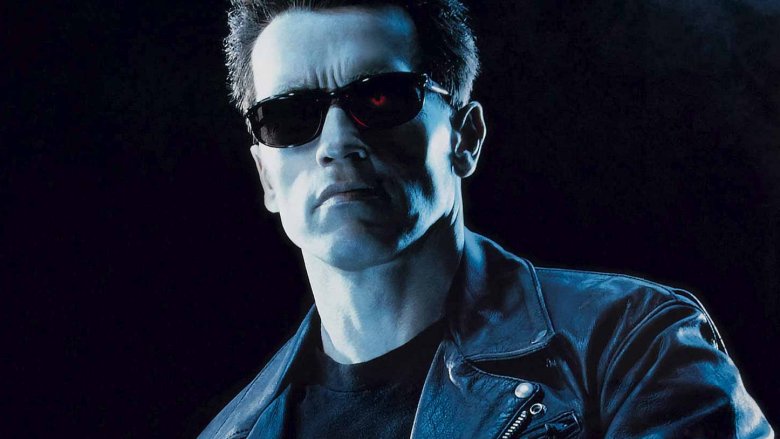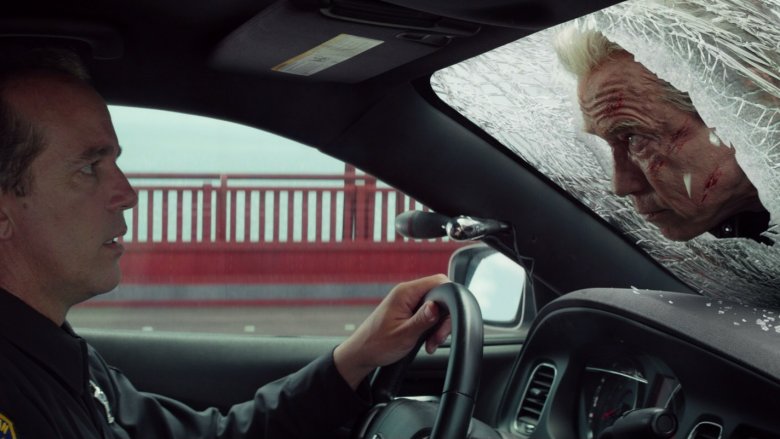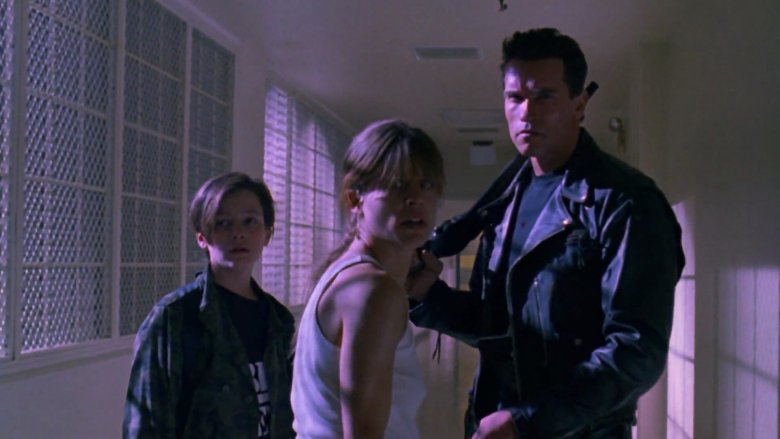These Things Happen In Every Single Terminator Movie
James Cameron only had one credit to his name when the first Terminator film was released in 1984. But despite his lack of directorial experience (and the film's tiny budget), The Terminator ranked first at the box office its opening weekend and went on to launch a billion-dollar franchise that would span more than three decades and six films.
Throughout the course of the series, Terminator's story — the core of which centers on an artificial intelligence gone awry that decides to obliterate the entire human race — has seen pretty much every new spin Hollywood can throw its way. From liquid Terminators and fractured timelines to a foul-mouthed Christian Bale, each and every film has dealt with a different aspect of the war between humanity and machines. But despite the new touches (and their varying degrees of critical success), there are a few things that every single Terminator movie has in common.
The threat of Skynet is always there
From the beginning, the Terminator series has always revolved around a single enemy: Skynet. The digital defense network was originally created by Cyberdyne Systems for use by the U.S. military, but the A.I. would instead turn on its creators and launch an all-out nuclear war. Interestingly, the date that Skynet became self-aware has changed throughout the franchise. Up through Terminator 2: Judgement Day, that date was August 29, 1997. By the time Terminator 3: Rise of the Machines took place, Skynet's development had been stalled, pushing the date back to July 25, 2004. Then, in Terminator Genisys, a fractured timeline led to yet another postponement of Judgement Day, this time in 2017.
More recently, Skynet has also been given a human face. In Terminator Salvation, Helena Bonham Carter became the first person to portray the A.I. system. In Genisys, it was played by several actors, although most notably by Matt Smith. Regardless of its particular face or its exact attack date, Skynet has been the primary antagonist in every one of the Terminator films, acting as puppeteer for each new killing machine.
A naked Terminator always shows up
There's a scene from the first Terminator that's become so iconic that it's been recreated in almost every film following the 1984 original. There's an empty street, a random gust of wind, and some lightning, all signaling the arrival of a futuristic robot. The first appearance of the Terminator has always been a memorable scene in the films, but it's usually remembered more for what's missing than for what's actually in it. And what's missing is always clothing.
While most of the time, the nude Terminator in question is the T-800 (the original Arnold Schwarzenegger version), Rise of the Machines took a different approach and recreated a near-identical arrival scene with its female Terminator, the T-X. The later films saw a return to the T-800, albeit with a minor modification or two. In Salvation, Austrian actor Roland Kickinger served as Schwarzenegger's younger body double, while Brett Azar took on the task for both Genisys and the upcoming Terminator: Dark Fate. Azar told The Terminator Fans that his Genisys fight scene against Schwarzenegger really was done in the buff (with the exception of "a sock/pantyhose with a drawstring").
We always get a machine's point of view
Almost as important to the Terminator series as the naked T-800, the machine head-up display (HUD) has become an essential shot in every film. It's used to give the audience a glimpse into the mind (processor?) of a Terminator, but it also tends to be a not-so-subtle reminder of the core difference between humanity and machinery. Specifically, when dealing with a Terminator that's on a kill mission, the majority of its HUD is tactical — scanning targets, searching addresses, and the like. In Judgement Day, we see a different kind of display analysis with the T-800's attempt to copy a smile, which demonstrates a shift in its character.
Early Terminator models utilize a red HUD, on account of its infrared mode. The later models (specifically Rise of the Machines' T-X) utilize a blue display. In Salvation, the majority of the machines shown are pre-T-800, so their displays range from red to grey. But regardless of the color, the machine's POV is always there.
Lots and lots of leather
In the Terminator universe, you aren't truly equipped for battle unless you're rocking some sweet leather threads. What started out as a necessary outfit choice in The Terminator — the punks that the T-800 first encounters just happen to be wearing the material — at some point became something of a joke. By Rise of the Machines, the best the T-800 could do was to steal the outfit off the Pleasure Men Fantasy Show's main attraction.
Thankfully, Salvation saw a return to the more functional leather jacket, as evidenced by both John Connor and Blair Williams. Meanwhile, Genisys gave us a tougher, leather-clad, 1984 version of Sarah Connor. But unfortunately, it also delivered a time-traveling John Connor who went from futuristic tactical gear to an ultra slick leather motorcycle jacket that felt less battle-ready and better suited for a ride along the Malibu cliffs on a $400,000 bike.
The signature catchphrases show up in every single movie
It only takes three words to immediately make somebody think of The Terminator: "I'll be back." It's the quote that put Arnold Schwarzenegger on the map ... and one the actor originally had trouble with. He told ABC News in 2012 that his accent prevented him from properly pronouncing the contraction. As the actor explained, "I just kept saying to Jim Cameron, 'Maybe I should just say 'I will.' He says, 'Look, I don't tell you how to act. Don't tell me how to write.'" The line would go on to become one of American Film Institute's 100 greatest movie quotes of all time, and it's been said by at least one character in every single Terminator film.
Similarly, the line "Come with me if you want to live" appears in all of the films, although it's uttered by a different character in nearly every installment. While you might think the T-800 owns this one as well, it's actually Kyle Reese who says it most — first in The Terminator and again in Salvation. John Connor has a variation of the line in Rise of the Machines, saying, "If you want to live, come on," which isn't nearly as cool as the original catchphrase.
There's grand theft auto in every Terminator film
Terminators are big on car theft. While it's certainly understandable that they'd be in need of a set of wheels immediately after having been dropped from the future (and who has time to procure a vehicle through proper channels?), the fact remains that at some point in every Terminator film, regardless of availability, someone needs to steal a car.
In The Terminator, the T-800 goes after an oil truck after he's been run over. Judgement Day went bigger, with the T-1000 taking over a helicopter. Rise of the Machines went with a motorcycle, Salvation made a return to the oil truck, and pretty much every kind of vehicle on the planet was stolen in Genisys, including a school bus and a police cruiser.
The best part about these thefts is that most of the time, there's someone actually still in the vehicle when it's stolen. So before the thief can set off on his or her big car chase, they always have to look at the frightened driver and drop some iteration of the phrase, "Get out."
A Terminator movie has got to have a big chase sequence
What's a Terminator film without a big chase scene? The 1984 Terminator set the standard for what would become a franchise staple, with a chase sequence involving numerous vehicles, including a motorcycle and the aforementioned oil truck. Judgement Day's vehicle chase runs on similar lines, with both a motorcycle and an 18-wheeler involved, although the production value and explosion level are both arguably much higher. Rise of the Machines goes all out and includes a veterinary pickup, a crane truck, and an entire fleet of police vehicles. And in a similar fashion, the Genisys chase utilizes a motorcycle, a bus, and a police car.
The biggest difference in the lineup is with Salvation. The post-apocalyptic setting allows for a different kind of chase, one that focuses primarily on outrunning actual sentient machines. We can also catch a glimpse of this type of action scene in Rise of the Machines, when the T-X hacks into the computer systems of the police cruisers, but Salvation's chase looks more like something out of a Transformers movie than anything else.
The T-800 is a franchise mainstay
Arnold Schwarzenegger was already in his late 30s the first time he played the T-800, a role that has since become a defining moment in his career as an actor. Interestingly enough, Schwarzenegger wasn't the studio's first choice to play the Terminator. In an interview with Deadline, James Cameron and producer Gale Anne Hurd said Orion Pictures head Mike Medavoy originally wanted O.J. Simpson in the role, and he wanted Schwarzenegger to play Kyle Reese. "I think I was on my knees retching," Cameron said.
Schwarzenegger has appeared in every one of the Terminator films to date, with the exception (sort of) of Salvation. That particular film got around the issue of his absence (the man was busy being a Governator) by superimposing the actor's face onto Roland Kickinger's body for the final confrontation between John Connor and the newly-minted T-800. Still, the T-800 itself has managed to make at least a cameo in all six of the Terminator films.
That moment when the Terminator isn't actually dead
Near the end of every Terminator film, once the battle against the killer machine is drawing to a close and the hero (or heroes) have reached the point of near-victory, there's always one final moment in which the Terminator rises up again for a last kill attempt. In The Terminator, the T-800 emerges from fire, stripped down to bare metal, and chases after Sarah Connor and Kyle Reese, successfully taking out the latter before it's finally crushed in a hydraulic press. A similar scenario plays out in Rise of the Machines and Salvation.
Meanwhile, both Judgement Day and Genisys utilize the later Terminator models' shape-shifting abilities in their end battles. However, Genisys puts its own original twist on the plot point, resurrecting the T-800 from a vat of liquid metal as a sort of T-1000 hybrid. It's the only film in the series that uses the "villain isn't really dead device" for one of its heroes, but it's still a Terminator coming back from certain extinction.
So much wall breaking
In speaking with Deadline in 2014, Gale Anne Hurd referred to The Terminator as a character-driven science fiction film, saying, "The plot revolves around choices the characters make, and the characters propel us into the story. Audiences respond to that." And while it's true that much of the Terminator franchise is built on character, at their core, these are action films. Or as Orion Pictures' head of marketing put it in 1984, they're "down and dirty action exploitation" films.
So it isn't surprising that each film would rely on an insane level of action to move them forward. Beyond extensive car chases and over-the-top final battles, there's one specific (and slightly smaller) bit of action that takes place in every single film, and it's wall-breaking. Whether it's throwing a Terminator or some other inanimate object through one in the middle of a fight or actually driving through one during a chase, there are always walls to be broken in a Terminator movie.
Can we trust him?
The question of trust always comes up in the Terminator franchise. In The Terminator, Sarah Connor struggles with whether or not to trust some random stranger who claims to have traveled back through time. Ultimately, she not only comes to trust him, but she falls in love with him. In the later installments, the question of trust turns to a more synthetic source. In Judgement Day, Sarah has to set aside her prior feelings toward the T-800 in order to trust it will protect her son. In Rise of the Machines, it's Kate Brewster, John Connor's future wife, who has to put her trust in the walking-talking killbot. Half of the entire plot of Salvation revolves around the human resistance putting their faith in Marcus Wright, a human-turned-cybernetic-infiltrator, to help defeat Skynet. In Genisys, it was between Kyle Reese and the old T-800. But while the same issue shows up in every film, it never gets old. The nature of trust is a fascinating theme for the series and, possibly, the most important one.
John Connor is the savior in every single movie (sort of)
John Connor didn't even exist in The Terminator, and yet he was the most important character in the film. "There was one man," Kyle Reese explained to Sarah Connor. "He turned it around. He brought us back from the brink. His name is Connor. John Connor. Your son, Sarah." John is the reason Kyle went back in time, he's the reason the original T-800 was sent back, and he's the reason more advanced Terminator models keep showing up in future films.
Without John — or the hope of John — the battle against Skynet would be lost, and the future of humanity would be doomed to face annihilation. In Salvation, Marcus Wright offers his heart to save him. Even in Genisys, when it's revealed that he's been transformed into the T-3000, there's still at least an initial hope that he can be saved, and that he can go on to protect his people.
Humanity over machinery
The biggest theme that runs throughout the Terminator series is that of humanity over machinery. Humans face extinction because they've become obsolete in a world dominated by technology. In a 2015 article on technophobia published by The Atlantic, Christopher Bader, a professor of sociology at Chapman, said, "People tend to express the highest level of fear for things they're dependent on, but that they don't have any control over, and that's almost a perfect definition of technology."
Skynet is the franchise's representation of this fear. With the exception of Salvation, which takes place post-Judgement Day, the driving force behind Terminator's characters is to prevent Skynet from coming online, an act that leads to its declaration of war against humans. In Salvation, the hope is to overthrow Skynet and return the world to humans. Skynet is seen as unfeeling, uncaring, and ruthless. Humans, at their best, are the exact opposite. It's the hope that humanity can face its fear of technology and fix its mistakes that runs through all of the films.













